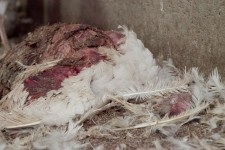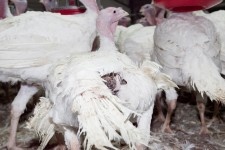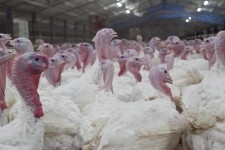'Tis the night before Christmas: Animal liberationists conduct a rescue to raise awareness of the shocking reality of turkey farming in Australia.
Submitted anonymously, December 2016
On farms and in slaughterhouses around Australia, turkeys endure shocking abuse, out of sight and out of mind. But this year during the week of Christmas a team of animal activists decided to enter one such farm. Equipped with camera gear and pillow slips, they hoped to both document and rescue some lucky birds to shine a light on these cruel and secretive operations at a time when most turkey is consumed in Australia.
In the middle of the night a group of activists huddled together close to the barbed wire fencing, nearby a turkey farm. They stood watching surrounded by trees – silhouetted by stars – its beauty breathtaking. The glimmer of turkey sheds in the distance became clearer as the activists headed off. Through the grass, into the canopy of trees, they moved swiftly past shadowy stationary trucks. Full of adrenaline, the activists threw themselves over the barbed wire fencing and headed straight toward the turkey sheds.
As the activists slid open the heavy shed door, a sea of young turkeys stood before them. The smell was so overpowering that the activists’ hands instinctively went up to cover their mouths and noses. One activist recalled: “It was quiet outside, but when the doors opened I was hit with a loud vibrating noise and an overwhelming smell”. This loud vibrating noise shattered the silence. Squinting in low light, the activists tried to make out where the shed ended. Thousands upon thousands of 4-6 week old turkeys (‘poults’) lay quietly. Corpses in varying states littered the ground.
What activists discovered was shocking, though, unfortunately, not surprising. “I was in shock. There were turkeys everywhere and so little room to move. Many were either too small, crippled or weak to reach the food and water outlets. There were dead bodies everywhere”, said one activist.
One special turkey caught the eye of an activist. The young turkey was much smaller than the others and more fragile. Poults are vulnerable to heart attacks and starving to death because many are unable to find the food and water points without the guidance of their mothers.
This is related to a condition known as ‘starve out’ when birds enter a state of shock and stop eating, ultimately dying from starvation. In the industry, there is an ‘accepted’ mortality rate because sick and smaller birds are not profitable for business.
This special poult was one of the first to be rescued. Without a doubt, she would have died by now if she had been left behind. The activists in the shed wrapped her up in a pillow slip, and carried her out along with the 11 other rescued turkeys. In a single file the activists journeyed back into the thick grass and trees. One activist recounted: "As I walked down the hill towards the shadows I couldn’t control the tears streaming from my eyes. I was overwhelmed with the feeling of joy and happiness having saved lives, but conflicted by the incredible sadness of having to leave thousands behind".
These twelve birds are now fortunate to be living out their lives in natural conditions where they can spread their wings, fly, perch, dust bathe, run and simply breath in the fresh air, rather than ending up on someone’s plate for Christmas. The footage captured during the rescue showed conditions that were virtually identical to previous investigations that featured in Animal Liberation ACT’s ‘Big Birds, Big Cruelty’ campaign. In 2011 and 2012 footage was released of turkeys raised in frightening conditions. It showed birds with no more space than an A3 size sheet of paper, muscle and skeletal disorders, physical injury such as bruising and scratching, and crippled legs and feet due to their fast growth and overweight bodies.
Not long after the release of this 2011-12 footage, Animal Liberation NSW obtained shocking footage of turkey abuse at an Ingham’s slaughterhouse. Over 136 instances of animal cruelty were recorded from cameras placed all over the shackling area, where birds are unloaded from trucks and placed onto the shackling line to be killed. In the footage, workers were seen kicking and punching turkeys, and bashing them against the floor and the side of the truck.
Flash forward to 2016 and nothing has changed in the turkey sheds. An activist on the team who has been conducting turkey investigations for several years remarked: "Every single time we have gone behind closed doors in a turkey farm we have seen ongoing abuse. This is not an exception. This is a systemic issue throughout the industry."
Most of the turkeys grown in Australia are sold into the Christmas market. It is not a popular meat throughout the year in Australia, but one mostly consumed at Christmas time when people want some turkey on their plate.
However big the problem, the rescue operation has made a world of difference to twelve turkey lives. Photos of the rescued turkeys show that. The activists remarked that there’s a quiet dignity in their faces that is reassuring. They are birds of courage and exude curiosity and an unexpected trust and friendliness given the conditions they have come from.
"There was immense grief when I looked down in my lap at the turkeys, as we drove them towards safety. Their quiet acceptance of our affection and care, the beginnings of trust is bittersweet. The knowledge that their siblings sweet and gentle nature will be abused, their trust so readily given, betrayed. Their lives stolen in the most brutal of ways. And the billions of animals this happens to, all the time, is never ending", said one activist.
To animal activists, that’s the beauty of a rescue – especially the week leading up to Christmas. The liberation not only helps the individual who has been rescued, but shows the conditions which billions of other animals in similar facilities must endure. The actual life situation of most animals in food production is a routine of violence, deprivation, suffering and death.
All animals have a strong will to live. They feel pain, pleasure, frustration, loneliness, and motherly love. Animal lives should not be considered objects to be subjugated and dominated by humans. All animal life has intrinsic value—that is, non-commodified sentience. "We don’t have a choice, we must do what we can, all that we can. We won’t be silenced while they continue to suffer... Until all are free, said one activist".
10. Download (186kb)
11. Download (221kb)
12. Download (186kb)
13. Download (208kb)
14. Download (65kb)
15. Download (268kb)
16. Download (167kb)
17. Download (514kb)
18. Download (485kb)
19. Download (160kb)
20. Download (225kb)
21. Download (426kb)
22. Download (498kb)
23. Download (434kb)
24. Download (143kb)
25. Download (256kb)
26. Download (195kb)
27. Download (345kb)
28. Download (245kb)
29. Download (375kb)
30. Download (176kb)
31. Download (248kb)
32. Download (481kb)
33. Download (193kb)
34. Download (533kb)
35. Download (266kb)







































